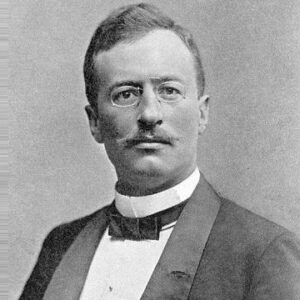Sven Hedin was a Swedish explorer, geographer, and travel writer. His trips to Central Asia led to important archaeological and geographical discoveries. During his series of expeditions, he not only found the sources of the Brahmaputra, Indus, and Sutlej rivers, but he also mapped the ruins of cities, grave sites, and the Great Wall of China in the deserts of the Tarim Basin. As a child, he wanted to travel, and when he was a teenager, he saw the Arctic explorer Adolf Erik Nordenskiold return from his first trip along the Northern Sea Route. This inspired him a lot. He decided to become an explorer himself and learned how to do so from Ferdinand Freiherr von Richthofen, a German geographer and China expert. From the end of the 19th century on, he went on several big trips to Central Asia. His travel notes and scientific writings about his trips added to what people in the West knew about the countries in Central Asia. He became known as an expert on Turkestan and Tibet. Along with people like Sir Francis Younghusband and Sir Aurel Stein, he took part in the struggle between Britain and Russia for power in Central Asia. He never got married and never had kids. At the time of his death, he gave the Royal Swedish Academy of Sciences the rights to his books and a lot of his other things.
Childhood and Adolescence
Sven Anders Hedin was born in Stockholm, Sweden, on February 19, 1865, to Abraham Ludvig Hedin and Anna Sofia Berlin. His father was the architect for the town.
Adolf Erik Nordenskiöld, a Swedish Arctic explorer, returned home when Hedin was 15 years old following his first passage of the Northern Sea Route. Hedin was enthralled by Nordenskiöld’s hero’s welcome and vowed to become an explorer himself.
Hedin graduated from Stockholm’s Beskowska secondary school in 1885. He traveled to Baku with his student Erhard Sandgren later that year and tutored him for seven months. He mastered Latin, French, German, Russian, English, and Tatar, as well as various Persian dialects, during this time.
From 1886 to 1888, he studied geology, mineralogy, zoology, and Latin under the supervision of geologist Waldemar Bigger. He was admitted as a Candidate in Philosophy in December 1888.
In Berlin, he completed his studies under Ferdinand Freiherr von Richthofen, a German geographer and China scholar. He also attended Alfred Kirchhoff’s lectures at the University of Halle-Wittenberg in Halle during this time. With a 28-page dissertation titled ‘Personal Observations of Damavand,’ he got his Doctor of Philosophy degree in 1892.
A Years Later
In October 1893, Hedin set out on a big journey from Stockholm to the Pamir Mountains, passing through Saint Petersburg and Tashkent. He traveled 26,000 kilometers over the next few years, mapping 10,498 kilometers on 552 sheets.
In 1899, he embarked on a new journey to Central Asia. He traveled to Calcutta via the Tarim Basin, Tibet, and Kashmir during this journey. He crossed the Yarkand, Tarim, and Kaidu rivers and discovered the dried-up lake bed of Lop Nur on this journey.
In the years 1900 and 1901, he endeavored but failed, to reach Lhasa. After that, he went to Leh and then to Lahore, Delhi, Agra, Lucknow, Benares, and Calcutta. The voyage resulted in the production of 1,149 maps.
Between 1905 and 1908, he toured Tibet’s Trans-Himalaya mountain range and researched the Central Persian desert basins, Tibet’s western highlands, and the Transhimalaya ranges. He was the first European to enter the Kailash region, which included the sacred Lake Manasarovar and Mount Kailash, during this journey. He returned from the journey with a collection of geological samples.
Between 1927 to 1935, he headed an international Sino-Swedish Expedition that explored the climatic, geographical, and prehistoric conditions in Mongolia, the Gobi Desert, and Xinjiang. During this time, he also conducted a Chinese mission on behalf of the Kuomintang government to examine irrigation methods.
At the conclusion of the journey in 1935, the great explorer found himself in a financial bind. He performed more than a hundred lectures in 91 German towns, as well as 19 seminars in bordering countries, to pay off his obligations.
‘Through Asia’ (1898), ‘Southern Tibet’ (13 vols., 1917–22), ‘My Life as an Explorer (1926), and ‘The Silk Road’ were among his writings (1938).
His Major Projects
Hedin’s research yielded significant archaeological and geographic findings. He was one of the first explorers to find the ruins of ancient Buddhist cities in Chinese Central Asia, and his expedition records paved the path for the careful charting of Central Asia.
Hedin conducted a Chinese mission on behalf of Chiang Kai-Kuomintang shek’s administration in 1933-34 to explore irrigation systems and draft infrastructure plans. His designs resulted in the development of extensive irrigation and road systems.
Achievements and Awards
Sven Hedin received numerous honors, including the Vega Medal (1898), the Livingstone Medal (1902), and the Victoria Medal (1903). (1903).
King Oskar II elevated Hedin to the untitled nobility in 1902, making him the last Swede to acquire a nobility charter.
In 1905, he was elected to the Royal Swedish Academy of Sciences, and in 1909, he was elected to the Royal Swedish Academy of Military Sciences.
In the United Kingdom, King Edward VII honored him as Knight Commander of the Order of the Indian Empire.
In 1933, the Berlin Geographical Society awarded him the Ferdinand von Richthofen Medal.
Personal History and Legacy
Sven Hedin did not marry or have children.
At the age of 87, he died on November 26, 1952. He gave the Royal Swedish Academy of Sciences the rights to his publications and his large personal items when he died. All ownership rights are held by the Sven Hedin Foundation, which was created shortly after.
Estimated Net worth
Sven is one of the richest and most well-known explorers. Based on what we know and what Wikipedia, Forbes, and Business Insider say, Sven Hedin is worth about $1.5 million.


